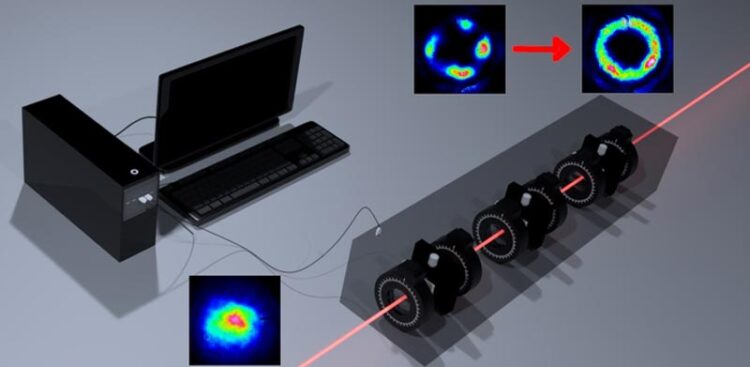Engineering high-dimensional quantum states

Scheme of automated platform to engineer arbitrary qudit states in the orbital angular momentum of photons. The experimental parameters are adaptively optimized for generation of target states.
Credit: Alessia Suprano, Danilo Zia, and Nicolò Spagnolo
An adaptive optimization protocol engineers arbitrary high-dimensional states to enable quantum information tasks that require finding optimal values of experimental parameters under noisy conditions.
The adoption of high-dimensional quantum states in quantum information protocols enables better performances in applications ranging from secure quantum communications to fault-tolerant quantum computation. Development of universal protocols able to engineer arbitrary high-dimensional quantum states would be a significant achievement. Several strategies and platforms have been proposed and developed to this end. Quantum-walk (QW) dynamics have been shown to allow development of universal, platform-independent state engineering protocols. However, the unavoidable presence of noise, and imperfections in the characterization of experimental apparatuses, diminish the overall quality of the state generation.
To overcome these limitations, a team of researchers from Sapienza Università di Roma, Queen’s University of Belfast, and Università degli Studi di Palermo, demonstrate the use of an adaptive optimization protocol that can engineer arbitrary high-dimensional states, as reported in Advanced Photonics. Within a fully black-box scenario, the protocol tunes the relevant experimental parameters relying only on the measured agreement between produced and target state, without needing a description of the generation setup.
The authors present an experimental verification of the proposed protocol using the orbital angular momentum (OAM) of classical light and single photons. OAM is a degree of freedom of the electromagnetic field related to its spatial and phase profile. Since the OAM is an infinite-dimensional degree of freedom, it is suitable for encoding arbitrary high-dimensional quantum states. The authors experimentally implement the protocol using a state-generation platform based on quantum-walk dynamics in the OAM and polarization degrees of freedom. By tuning the parameters of the operators acting on the polarization state, an arbitrary walker state encoded in the OAM space can be engineered. The proposed optimization algorithm then performs an online tuning of the experimental parameters driving the dynamics to obtain the desired outcome.
The optimization protocol is shown to perform well when subject to experimental noisy conditions, for several four-dimensional target OAM states. Finally, the team investigated the adaptability of the protocol by introducing time-varying noise as external perturbation on the values of the parameters. The protocol found the new optimal solution after the introduction of these external perturbations. The proposed protocol is applicable in a wide variety of circumstances, even in presence of disturbance, without needing significant fine-tuning.
According to senior author Fabio Sciarrino, head of the Quantum Information Lab in the Department of Physics of Sapienza Università di Roma, “The proposed dynamical learning protocol will be beneficial for several quantum information tasks that require finding optimal values of experimental parameters under noisy conditions.”
Read the original open access research: Suprano et al., “Dynamical learning of a photonics quantum state-engineering process,” Adv. Photonics 3(6), 066002 (2021) doi 10.1117/1.AP.3.6.066002.
Journal: Advanced Photonics
DOI: 10.1117/1.AP.3.6.066002
Method of Research: Experimental study
Article Title: Dynamical learning of a photonics quantum-state engineering process
Article Publication Date: 13-Dec-2021
Media Contact
Daneet Steffens
SPIE–International Society for Optics and Photonics
daneets@spie.org
Office: 360-685-5478
All latest news from the category: Physics and Astronomy
This area deals with the fundamental laws and building blocks of nature and how they interact, the properties and the behavior of matter, and research into space and time and their structures.
innovations-report provides in-depth reports and articles on subjects such as astrophysics, laser technologies, nuclear, quantum, particle and solid-state physics, nanotechnologies, planetary research and findings (Mars, Venus) and developments related to the Hubble Telescope.
Newest articles

Innovative 3D printed scaffolds offer new hope for bone healing
Researchers at the Institute for Bioengineering of Catalonia have developed novel 3D printed PLA-CaP scaffolds that promote blood vessel formation, ensuring better healing and regeneration of bone tissue. Bone is…

The surprising role of gut infection in Alzheimer’s disease
ASU- and Banner Alzheimer’s Institute-led study implicates link between a common virus and the disease, which travels from the gut to the brain and may be a target for antiviral…

Molecular gardening: New enzymes discovered for protein modification pruning
How deubiquitinases USP53 and USP54 cleave long polyubiquitin chains and how the former is linked to liver disease in children. Deubiquitinases (DUBs) are enzymes used by cells to trim protein…


